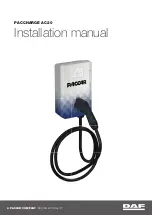
39
COMPRESSED NATURAL GAS
INTRODUCTION
The compressed natural gas (CNG) fuel system consist of DOT certified storage tanks that store CNG at
up to 3000 psi that replace the fuel tank, a structure to hold and protect the tanks, metallic fuel lines to deliver
the fuel, high and low pressure regulators to reduce the pressure entering the throttle body, a fuel shutoff
solenoid and the throttle body which delivers the CNG/air mixture to the engine. The regulator includes an
integral heater to preheat the CNG for anti-icing control.
A pressure relief system is part of the fuel system. This system is designed to vent the tank contents when
pressure and temperature become excessive.
A fill connection is located near the entrance of the bus.
If so equipped, the engine powering this bus is engineered specifically for use with CNG. Operation and
maintenance procedures are similar to those used on gasoline or diesel engine vehicles. Differences identi-
fied are obvious.
OWNER / OPERATOR RESPONSIBILITIES
The owner/operator should be aware of the code requirements and be familiar with applicable codes
which apply to the area of operation. The owner/operator should be aware that fuel cylinders for CNG
(Compressed Natural Gas) must be inspected every three (3) years in accordance with NGV-2 specifications.
The owner/operator should be aware that cylinder expiration date is fifteen (15) years after date of cylinder
manufacture and that cylinders must be replaced. This testing and certification is not covered by Blue Bird
warranty.
WARNING: Due to the dangerous potential of high pressure cylinders, it is suggested that anyone in-
volved in their use be completely familiar with the Department of Transportation “Code of Federal Regu-
lations Title 49” and the various Compressed Gas Association pamphlets that are available covering the
care and use of high pressure cylinders. Regulations do not permit filling NGV cylinders with an over-
charge.
NATIONAL FIRE PROTECTION ASSOCIATION #52 states:
Cylinders shall be manufactured, inspected, marked, tested, retested, equipped and used in accordance
with U.S. Department of Transportation (DOT) or Canadian Transport Commission (CTC) regulations, ex-
emptions or special permits specifically for CNG service and shall have a rated service pressure of not less
than 2400 psig at 70 Deg. F. (16.5 MPa at 21.1 Deg. C).
Pressure vessels shall be manufactured, inspected, marked and tested in accordance with the rules for
construction of unfired pressure vessels, Section VIII (Division 1), ASME Boiler and Pressure Vessel Code.
When a vehicle is involved in an accident or fire causing damage to the CNG container, the CNG con-
tainer shall be replaced or removed, inspected and retested in accordance with the document under which it
was originally manufactured before being returned to service.
When a vehicle is involved in an accident or fire causing damage to any part of the CNG fuel system, the
system shall be retested before being returned to service.
Damaged supply lines shall be replaced, not repaired.
The owner or user or both shall maintain all containers, container appurtenances, piping systems, vent-
ing systems and other components in a safe condition.
As a precaution to keep pressure relief devices in reliable operating condition, care shall be taken in the
handling or storing of compressed natural gas containers to avoid damage. Care shall also be exercised to
avoid plugging by paint or other dirt accumulation of pressure relief device channels or other parts which
could interfere with the functioning of the device. Only qualified personnel shall be allowed to service pres-
sure relief devices. Only assemblies or original manufacturer's parts shall be used in the repair of pressure
relief devices unless the interchange of parts has been proved by suitable tests.
















































